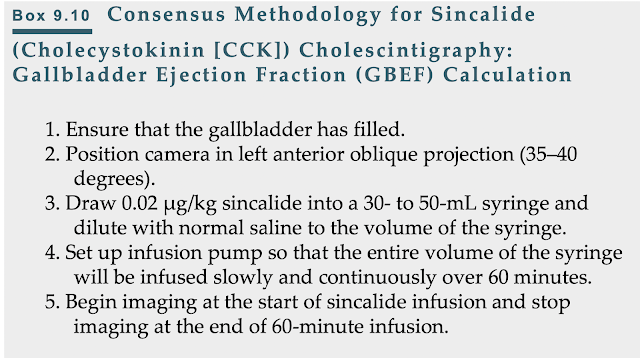- Introduction:
- Recurrent episodes of right upper quadrant pain, usually in a middle- aged female, although occasionally in men and children, are suggestive of chronic cholecystitis.
- The clinical diagnosis is often confirmed by detection of gallstones on sonography.
- The standard therapy is cholecystectomy; gallbladder histopathology shows evidence of chronic inflammation.
- On occasion, a clinician suspecting that a patient’s pain is not due to cholecystitis and that the gallstones seen are incidental may refer the patient for cholescintigraphy and a GBEF.
- Although chronic cholecystitis classically shows delayed filling after 60 minutes, some cases will show normal gallbladder filling.
- When CCK is administered after gallbladder filling, patients with asymptomatic cholelithiasis will have normal gallbladder contraction, whereas patients with chronic cholecystitis have a poor gallbladder response.
Chronic Acalculous Gallbladder Disease
- The acalculous form of chronic cholecystitis occurs in approximately 10% of patients with symptomatic chronic gallbladder disease.
- It is clinically and histopathologically indistinguishable from chronic calculous cholecystitis, except that there are no gallstones.
- This entity has been called by various names in the literature and by referring physicians, including gallbladder dyskinesia, gallbladder spasm, cystic duct syndrome, and functional gallbladder disease.
- Patients present with recurrent right upper quadrant biliary colic, have poor gallbladder contraction, and are usually cured with cholecystectomy.
- Many investigations have found that sincalide cholescintigraphy can confirm the suspected clinical diagnosis of chronic acalculous gallbladder disease.
- A poor GBEF predicts postcholecystectomy symptomatic relief and histopathological evidence of chronic gallbladder inflammation; a normal GBEF excludes the disease.
- There is only one small (21 patients) randomized prospective study. In that study, 92% were cured with surgery.
- Sincalide cholescintigraphy should be performed on an outpatient basis after a clinical evaluation has excluded other diseases.
- It is best performed as an outpatient because acute illnesses and numerous therapeutic drugs can adversely affect gallbladder contraction and result in a false-positive study.
Sincalide Infusion Methodology
- A consensus report published by expert gastroenterologists, surgeons, and nuclear medicine physicians recommended that the 60-minute infusion method should become the standard methodology.
- Follow me on Twitter @RutujaKote for more discussions about topics in Nuclear Medicine and Radiology.






No comments:
Post a Comment